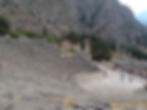Geeking Out in Greece: Ancient Delphi
- lotzacurls
- Nov 9, 2019
- 3 min read
Updated: Jul 19

Fantastically located on the flank of Mount Parnassos, Ancient Delphi works well as a day tour from Athens, paired with a quick stop to see Thermopylae, site of the epic battle depicted in the movie 300.
Collection of photos Greece
Delphi was one of Ancient Greece’s most popular tourist and pilgrim sites from 600 BC until 400 AD. People came from all over Europe and Asia and dropped a lot of coin to get advice from the Oracle, who claimed to speak for the god Apollo.
The story goes like this: Zeus sent two eagles flying across the planet, in opposite directions, and they reunited here. So Delphi thrived for nearly a thousand years, as it was considered the center of the world.
This was a very rich and autonomous community. The Sacred Way, Delphi’s main street, was lined with gold, bronze and marble statues, all dedicated to Apollo. City-states like Athens, Sparta and Corinth were in fierce competition with one another and erected lavish monuments in Delphi in an effort to dwarf or intimidate one another. People paid small fortunes to have their success stories carved into stone walls or buildings. Freed slaves gave much of their savings away in order to carve their freedom stories onto The Sacred Way’s walls. Countless temples were built in the city as a thank-you to Apollo, to ensure his favor. Countries even built marble treasuries to house their riches, confident that Apollo would safeguard it.

If you had been a world leader at this time in history, you probably wouldn’t have made any major decisions without first consulting the Oracle. Among the many Kings that came here seeking advice, Alexander the Great was probably Delphi’s most famous guest.
There was even a stadium that seated 7 000 spectators, still the best-preserved stadium in all of Greece.


The Tholos is the most striking monument here, in my opinion. Built in 500 BC, it had 20 marble columns and was the only round temple in Delphi.
An eternal flame burned in the Temple of Apollo, where the Oracle lived. Inside the temple, Delphic Commandments were etched in stone, philosophical quotes from Socrates like «Know Thyself» and «Nothing In Excess» which still resonate today.
The coolest, most mystifying thing about Delphi was this famous Oracle: a priestess, or pythia (who served as a channeller of Apollo) and a priest (who interpreted her channelled prophecies). No one seems to know how the pythia or priests were selected for their posts.
Visitors to the Temple of Apollo would consult with the priest, who would then relay their questions or dilemmas to the pythia. She remained behind a curtain inside the Temple; no one could speak with her directly, save the priest. Behind her mysterious shroud, she would inhale fumes coming out of a well in the ground, which intoxicated her and sent her into trances or delirium. Her subsequent answers, often unintelligible, would then be ‘translated’ by the priests. They were well-versed in the politics of the moments, being heavily engaged with the gossiping crowds at Delphi.
The vague and ambiguous advice that came out of Delphi had much to do with its millenium-long success; humans have always heard what they want to hear. This is how the priests of Delphi wielded real power; with their words, entire fates were forged. Wars were started or ended, political marriages were arranged, rivals were put to death, and kings were sent on world-wide pilgrimages and military conquests.
Scientists now know that the Temple of Apollo was purposely built onto two fissures, from which traces of ethylene gas still leak. This was known to the architects and priests at the time and was revered as sacred ground. In 373 AD, a powerful earthquake closed up most of the fissures that had been there beforehand, cutting off much of the strong ethylene fumes that Delphi depended upon for its success. Scholars today believe that the destruction of this fissure contributed directly to its demise. It continued to degenerate from fires and earthquakes and was ultimately destroyed in the late 4th century by a Christian emperor.
Delphi’s setting is stunning and the ruins are still awe-inspiring. We are left to gawk at what little remains of its ancient structures.

I booked both tours of Ancient Delphi and Thermopylae through my hostel in Athens. Same with my overnight tour of Meteora (link coming soon), which I very strongly recommend.
See more Photos of beautiful Greece
